Kerala Plus One Zoology Chapter Wise Previous Questions Chapter 2 Animal Kingdom
Question 1.
Rearrange the following in the correct taxonomic hierarchical sequence: (MARCH-2010)

Answer:
Sapiens → Homo → Hominidae → Primata → Mammalia → Chordata.
Question 2.
Observe the organization chart given below and fill appropriately. No need to redraw the chart. (MARCH-2010)
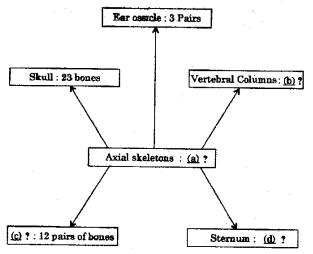
Answer:
a) 80
b) 26
c) Ribs
d) 1
Question 3.
Classify the organisms below based on segmentation: (MARCH-2010)
a) Ascaris
b) Taenia
c) Fasciola
d) Wuchereria
e) Neries
f) Pheretima
Answer:

Question 4.
Match Column B and C with Column A. (MARCH-2010)

Answer:

Question 5.
Group the following animals on the basis of symmetry and given a suitable title for each category. (SAY-2010)
Asterias, – Hirudinaria, – Octopus, Hydra
Answer:
Asterias – Echinodermata, Hirudinaria – Annelida, octopus – Molluscs, Hyrda – Coelenterata (Cnidaria)
Question 6.
The flow of sea water through the canal system of sponges is shown using arrows. Fill the gaps marked as a and b with the help of the diagram given. (SAY-2010)
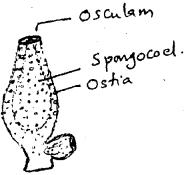
Answer:
a) Ostia
b) Osculum
Question 7.
Find the odd one from each group. Justify your answer. (SAY-2010)
a) Dog fish, Hag fish, Sawfish, Flying fish
b) Glutamic acid, Lysine, Valine, Collagen
Answer:
a) Hag fish
b) collagen
Question 8.
A taxonomist described a new organism as triplo- blastic, radially symmetrical, coelomate and without metameric segmentation: (SAY-2010)
a) What do you understand by each term of his description?
b) Give an example of an organism of the same phylum that he had described.
Answer:
a) Trioloblastic – The developing embryo of an animal has a third germinal layer, mesoderm, in between the ectoderm and endoderm, is called
triploblastic animal.
Radially symmetrical – When any plane passing through the central axis of the body divides the organism into two identical halves, it is called radial symmetry.
Coelomate – The body cavity, which is Iined by mesoderm is called coelom. Animals possessing coelom are called coelomates
Without Metameric segmentation – The body is not divided externally and internally into segments
b) Phylum echinodermata.
Question 9.
Figure A and B are the fishes of two different classes. Identify and differentiate between these classes. (MARCH-2011)

Answer:
Chondrichthyes or cartilagenous fishes
B) Osteichthyes or Bony fish
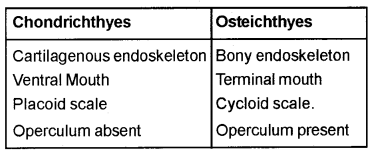
Question 10.
Complete the columns using the appropriate phylum, distinctive features and excretory organs. (MARCH-2011)

Answer:
a) Flat body
b) Flame cells
c) Jointed appendages/chitinous exoskeleton
d) Annelida
e) Nephridia
f) Echinodermata
Question 11.
Rearrange the following statements in two column (SAY-2011)
table and give suitable heading for each group.
Notochord is present
Post anal tail is absent
Pharynx is perforated by gill slits
Notochors is absent
Post anal tail is present
Gill slits are absent
Answer:
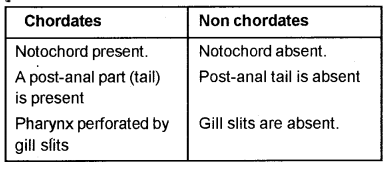
Question 12.
Complete the table using correct terms. (SAY-2011)

Answer:
A – Gnathostomata
B – Pisces
C – Osteichthyes
D – Reptilia
Question 13.
Find the relationship between given words and suggest the suitable word for the fourth place. (MARCH-2012)
a) Annelida : Nephridia ::
Arthropoda : ……………..
b) Osteichthyes : Cycloid scales : :
Chondrichthyes : ………………
Answer:
a) Malphigiantubles/Green glands
b) Placoid scales.
Question 14.
Match column I with II. (MARCH-2012)
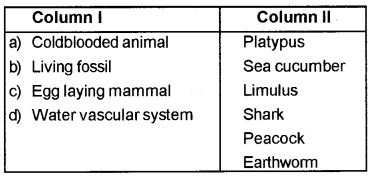
Answer:
a) Malphigian tubles / Green glands
b) Placoid scales.
Question 15.
The following diagram shows the characteristics of a phylum. (MARCH-2012)

a) Identify the phylum.
b) Label A in the diagram.
c) Mention foursalient features of the phylum.
Answer:
a) Cold blooded animal – Shark
b) Living fossil – Limulus
c) Egg laying mammal – platypus
d) Water Vascular system – Sea cucumber
Question 16.
Fill in the blanks (SAY-2012)
Coelomate : Arthropoda ::
Psuedocoelomate : ……………..
Answer:
Aschelminthes or Nemathelminthes.
Question 17.
Is it possible to compare the water vascular system of phylum Echinodermata to circulatory system of man in some aspeyafe? Justify your answer. (SAY-2012)
Answer:
Yes- It helps in transport of food. It helps in respiration.
No – It helps in locomotion. It helps in the capture of food.
Question 18.
Organisms of this phylum are radially symmetrical, triploblastic and coelomate with a complete digestive system.
a) Identify the phylum. (SAY-2012)
b) Give an example forthis phylum.
c) What are the distinctive features of this phylum?
Answer:
a) Echinodermata
b) Starfish
c) They are triploblastic and coelomate animals.
Question 19.
a) Pick out the acoelomate organism from the following: (MARCH-2013)
i) Round worm
ii) Hookworm
iii) Filarial worm
iv) Tapeworm
b) Name the phylum to which it belongs.
c) Mention its mode of nutrition.
d) What is the coelomic condition of other organ-isms? Substantiate your answer.
Answer:
a) tapeworm
b) Platyheliminthes
c) parasitic or absorption through body surface
d) pseudoceolomate
In acselminthes celom is not lined by mesoderm
Question 20.
During a seashore visit, a student collected two or-ganisms. Observing the morphology, it is clearthat the organisms are radially symmetrical. One of them shows bioluminescene. (MARCH-2013)
a) To which phylum does this organism belong?
b) Identify the possible phyla to which the other or-ganism can be included.
c) Which distinctive feature of this organism will help you to categorize it into a particular phylum?
Answer:
a) Ctenophora
b) Coelentrataor or Echinodermata
c) Water vascular system or tube feet
Question 21.
Rearrange both the biological category and Taxon based on taxonomical hierarchy. (MARCH-2013)
[Hint – The last two terms of taxon will give the scien-tific name of housefly]
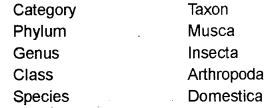
Answer:
Arthropoda → Insecta → Musca → Domestica
Question 22.
Observing starfish in a marine aquarium your friend commented that itisfa lower invertebrate without dis-tinct head, eyes and legs. Do you agree with him? Evaluate his statement with reasons. (SAY-2013)
Answer:
Yes, Star fish belongs to the kingdom Echinodermata. These animals have endoskeleton of calcareous ossicles. All are marine with organ system level of organization.
Question 23.
The following are the key characteristics of an animal group. (SAY-2013)
Circular and sucking mouth without Jaws.
Fish like body without scales and paired fins.
a) Name the class in which this animal belongs.
b) Give two examples from this class.
Answer:
a) Cyclostoma
b) petromyzon and Myxine
Question 24.
Frogs, Salamanders, Tortoise and Crocodiles are seen in both water and land. But they are classified into two different classes of the phylum Vertebrata. Evaluate this classification comparing salient features of each class. (SAY-2013)
Answer:
Frog and Salamanders belongs to class amphibian. Skin is moist without scales. Sexes are separate and fertilisation is external.
Tortoise and Crocodiles belongs to class Reptilia. Heart is usually three chambered and four chambered in crocodiles. Sexes are separate and fertilization is internal.
Question 25.
“All vertebrates are chordates but all chordates are not vertebrates.” Evaluate and substantiate the statement. (MARCH-2014)
Answer:
a – Vertebrate have notochord in the embryonic stage
b – All chordates lack vertebral column
c – Vertebrates are chordates with vertebral column
Question 26.
Name the distinctive character (responsible for their names) of the following animal groups, (MARCH-2014)
a) Cnidaria
b) Arthropoda
c) Porifera
d) Annelida
e) Chordata
f) Ctenophora
Your Biology teacher exhibited a laboratory specimen in the classroom. Based on which features will you distinguish it as a chordate or a nonchordate?
Answer:
a) Cnidoblast or stinging cells
b) Jointed foot or appendages
c) porous body
d) Metamerism or compartmentalised
e) Notochord
f) Comb plates
OR
Chordates
1) notochord present
2) Gill slits present
3) Postal anal tail present
Non chordates
notochord absent
Gill slits absent
Postal anal tail absent
Question 27.
Find the relationship between the first pair and fill in the blank. (SAY-2014)
Salamander : Amphibia
chameleon : …………..
Answer:
Reptilia
Question 28.
Mention the function of the following : (SAY-2014)
a) Blood glands of‘Pheretima’
b) Hepatic caeca of ‘Periplaneta americana’.
Answer:
a) Blood glands are present on the 4th, 5th and 6th segments. They produce blood cells and haemoglobin which is dissolved in blood plasma, b) Hepatic caeca or gastric caecae is present at the junction of foregut and midgut, which secrete digestivejuice.
Question 29.
Prawns and insects are included in the phylum arthropoda while they have different habits and habi-tats. Justify your answer. (MARCH-2015)
Answer:
Because
a) They have jointed appendages
b) Excretion takes place through malpighian tubules
c) Body covered by chitinous exoskeleton
Question 30.
Figures (X) and (Y) are the fish of two different classes. Identify them and differentiate between these classes. X, Y (MARCH-2015)

Answer:
X- Scoliodon Y-Catla
Scoiiodon – belongs to the class- Chondrichthyes. The skin is tough, containing minute placoid scales. Catla – belongs to the class Osteichthyes. Skin is covered with cycloid/ctenoid scales.
Question 31.
Birds are well adapted for flying. Give any three of such adaptations. (MARCH-2015)
OR
All vertebrates are chordates, but all chordates are not vertebrates. Justify this statement with an example.
Answer:
The forelimbs are modified into wings.
Skin is dry without glands except the oil gland at the base of the tail.
Endoskeleton is fully ossified (bony) and the long bones are hollow with air cavities (pneumatic)
OR
The members of subphylum Vertebrata possess notochord during the embryonic period. The notochord is replaced by a cartilaginous or bony vertebral column in the adult. Thus all vertebrates are chordates but all chordates are not vertebrates.
Question 32.
Observe the following features of animals and answer the following questions. (SAY-2015)
Moist skin
Hooks and suckers
Pneumatic bones
Dry and nonglandular skin
Metamerism
a) Select the flight adaptation of birds.
b) Select the amphibious adaptation of frog.
Answer:
a) puematic bones
b) moist skin
Question 33.
Assign the following features of animals given in Column A to the most appropriate animal phylum given in Column B. (SAY-2015)
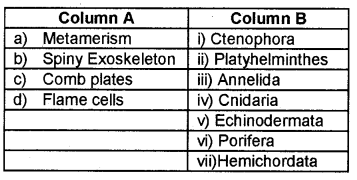
Answer:
pa) Metamerism – Annelida
b) spiny exoskeleton – echinodermata
c) comb plates – ctenophore
d) flame cells – platiffelminthes
Question 34.
The diagrammatic sketch given below represents a hypothetical chordate. (SAY-2015)
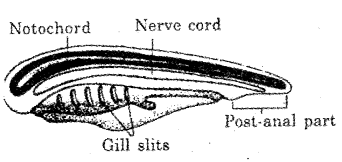
a) If you find any mistake in the labelled parts, copy the diagram and make necessary corrections in the labelling.
b) Based on any two labelled parts in the diagram, mention how this phylum differs from nonchordates.
Answer:
a) In the place of notochord is nerve cord while in the place of nerve cord is notochord . The other labellings are correct.
b) In non chordates notochord and post anal tail are absent.
Question 35.
The characteristic features of an invertibrate is given. “The phylum includes the comb jellies, also called walnuts. They are noted for their bio-luminescence and comb plates.” Identify the phylum. (MARCH-2016)
Answer:
Ctenophora
Question 36.
Fill in the blanks with appropriate word: (MARCH-2016)
Osteichthyes: Cycloid scales
Chondrichthyes: ………….
Answer:
Placoid scales
Question 37.
Name the phyla in which the following cells/struc-tures/ organs are present, (MARCH-2016)
a) Radula
b) Cnidoblast
c) Pneumatic bone
d) Proboscis gland
Answer:
a) mollusca
b) cnidaria-coelenterata
c) chordate-Aves
d) Hemichordata
Question 38.
The following diagram shows the characteristic fea-tures of a phylum. (MARCH-2016)
a) Identify the phylum.
b) Mention four salient features of this phylum.
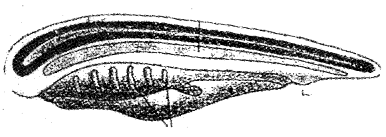
Answer:
a) chordate
b) 1. notochord is present,
2. post nal tail is present
3. pharyngeal gill slit is present,
4. ventral heart is present
Question 39.
Characters of a marine invertebrate is given. (SAY-2016)
– Spiny skinned body
– Presence of water vascular system
a) Identify and write the phylum.
b) Write any two functions of water vascular system among them.
Answer:
a) Echinodermata
b) Locomotion and Respiration
Question 40.
Identify the cell given in the diagram. (SAY-2016)
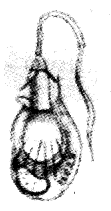
b) Mention the name of animal phylum based on this cell.
Answer:
a) Cnidoblast
b) Cnidaria/Coelenterata
Question 41.
Two examples of fishes are given. (SAY-2016)
– Scoliodon (Dogfish)
– Exocoetus (Flying fish)
a) Place them in two distinct classes.
b) Differentiate the above classes on the basis of two important characters.
Answer:
a) Chondrichthyes- Cartilaginous fish Osteichthyes-Bony fishes b) Chondrichthyes
1) Gill slits are separate and without operculum (gill cover).
2) The skin is tough, containing minute placoid scales
b) Osteichthves
1) Skin is covered with cycloid/ctenoid scales.
2) Air bladder is present which regulates buoyancy
Question 42.
Match the items in columns B and C with A.) (MARCH-2017)
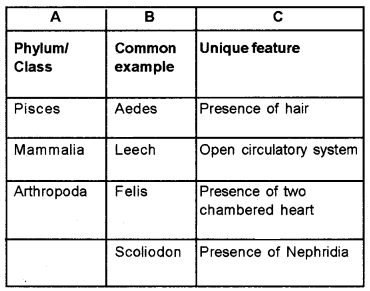
OR
Features of different phyla/ class are given below. Identify the phylum/ class and give examples of each group.
a) Body is covered by scales, heart is three or four chambered. They respire through lungs.
b) They are exclusively marine, commonly called sea walnuts and shows bioluminescence.
c) Body is divided into proboscis, collar and trunk. They have open circulatory system and presence of proboscis gland.
Answer:

OR
a) Reptilia, eg: Chameleon
b) Ctenophora, eg: Ctenoplana
c) Hemichordata, eg: Balanoglossus
Question 43.
Among the different phyla of animals have pseudocoelom. (MARCH-2017)
Answer:
Aschelminthes